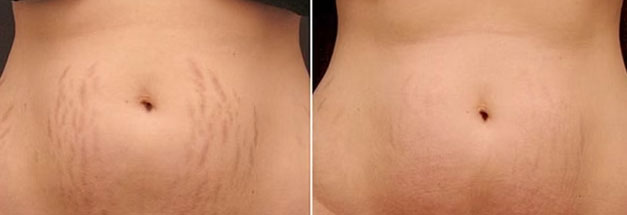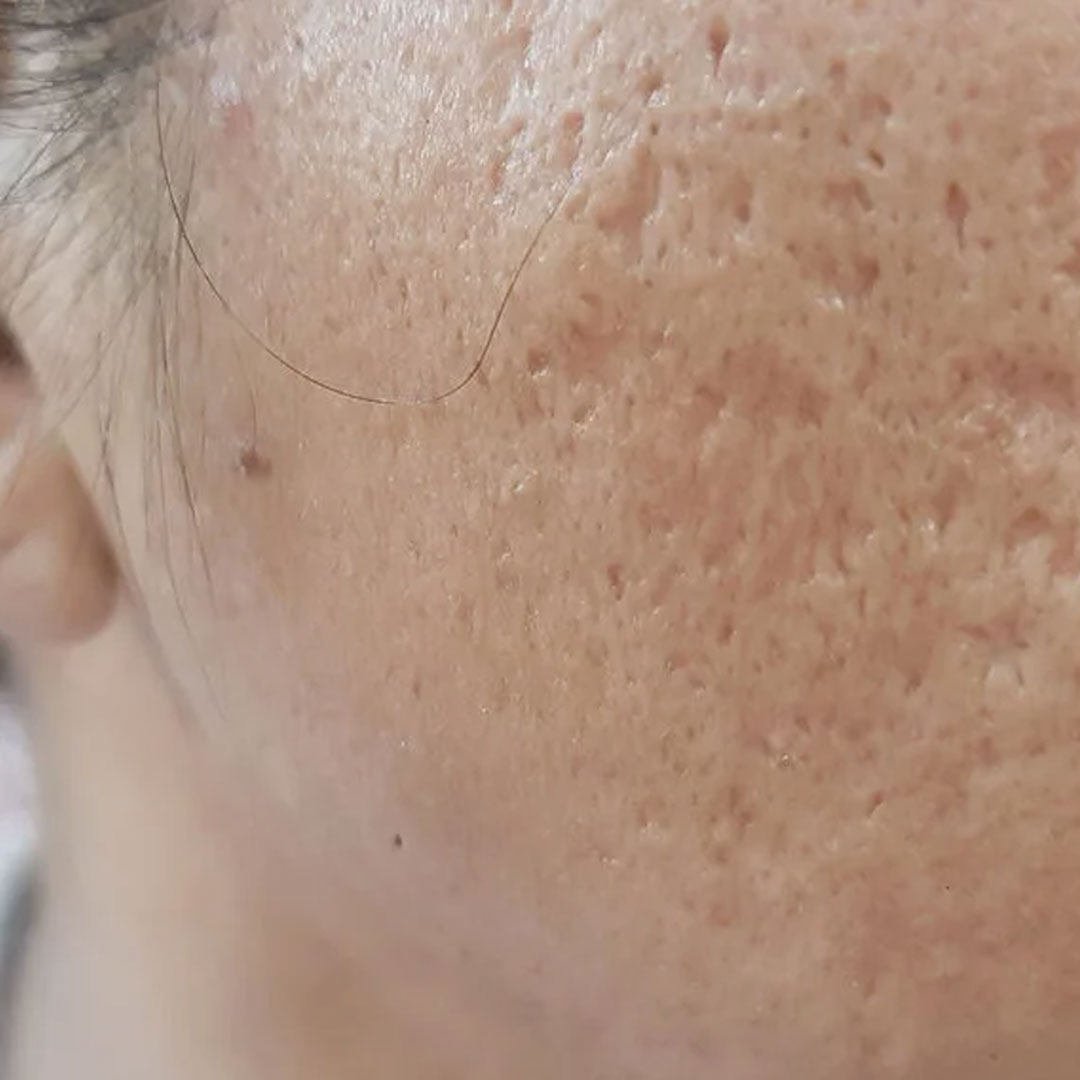Scar Revision Treatments Scottsdale
Scar Treatments at Rejuvience Med Spa Scottsdale
Scar revision treatments reduce and can even eleminate the appearance of scars caused by an injury, wound, acne lesions, poor healing, acne, or surgery.
Most scars need 12 to 18 months to heal before revision treatments begin because new scars usually don’t respond well.
During the first 12 months following a skin injury medical grade bioactive topicals can help reduce creation scar tissue.
Optimal scar revision treatment recommendations require a complimentary consultation. There’s no cost, and there’s no obligation. During your appointment, we’ll discuss your concerns and treatment options.

Stretch Mark Treatments Scottsdsale
Stretch marks are atrophic (depressed) scars that are caused by the skin stretching or shrinking too quickly, leading to damage to the collagen and elastin fibers, resulting in visible, discolored lines.
Today’s fractional treatments can dramatically diminish stretch marks. A complimentary consultation for stretch mark treatments is required.

Acne Scar Treatments Scottsdale
Acne scars are usually atrophic, meaning a depressed scar that heals below the normal layer of skin tissue.
There are three main types of atrophic acne scars:
- Boxcar Scars, which look like round or oval craters in the skin
- Ice pick scars, which are small, deep, narrow scars
- Rolling scars, which form when bands of scar tissue grow under the skin, giving it an uneven appearance
Because acne scars can vary so dramatically from person to person, a complimentary consultation is required.

Surgical Scar Treatments Scottsdale
An ideal surgical scar is one that is largely undetectable, meaning that the tissue is at the same level as the adjacent tissue and has the same color as the surrounding skin.
Surgical scar treatment can begin with advanced regenerative topicals and LED Light Therapy that help ensure the wound heals properly.
Once a surgical scar has completely healed, tissue level disparity and coloration differences can be assessed for a treatment plan.
Surgical scar treatment plans require a complimentary consultation. There is cost, and there is no obligation.
About Scars
What Are The Types of Scars?
Superficial Scars
Superficial scars are long, thin, and typically flat. They do not cause any issue other than an unsightly appearance.
Contractures
Contractures are scars that restrict movement due to skin and underlying tissue after a large area of skin is damaged. The scar that is formed pulls the edges of the skin together, which causes a tight area of skin. The contracted skin can affect the muscles, joints, and/or tendons, causing a decrease in movement.

About Atrophic Scars
Atrophic scars form when the skin is unable to regenerate tissue which leaves a sunken appearance. Atrophic scars are often caused by acne or burns.
Atrophic scars are further categorized into boxcar, icepick, or rolling scars.
Boxcar scars are wider than they are deep and have sharply defined edges.
Icepick scars are narrow pitted scars that are deeper than they are wide.
Rolling scars are broad depressions with sloping edges.
Atrophic scars typically respond particularly well to medical microneedling.
About Hypertrophic and Keloid Scars
Hypertrophic scars are thick clusters of collagen caused when there is tension on the skin at a wound. They are often red, but may be darker or lighter than the surrounding skin. They may also be itchy or painful.
Hypertrophic Scars are often thick and raised, but not as raised as keloid scars. While they do not grow beyond the boundaries of the original wound, if untreated, they may become wider over time.
Keloid scars are larger than hypertrophic scars, but like hypertrophic scars can be painful or itchy. Unlike hypertrophic scars, keloid scars expand in claw-like growths over normal skin and extend beyond the edges of an original wound.
Keloid scars may also pucker. Keloid scars are caused by an overgrowth of collagen during wound healing. Colors vary from pink to the color of the person’s skin to red to dark brown.

Our Scottsdale Scar Revison Treatments
While it seems counterintuitive, treating scar tissue by causing controlled damage to the scar tissue damage allows new, healthier and more normal looking tissue to form. Minor scars can often be almost completely erased. Larger scars can have their appearance reduced, sometimes dramatically, with complete scar removal possible in some cases.
When to have scar revision treatments is not always clear. Scars do shrink and become less noticeable as they age. Each scar is different, and the type of scar you have and other factors determine the optimal treatment regime.
Optimal scar revision treatment recommendations require a complimentary consultation. During your appointment, we’ll discuss your concerns and treatment options. There’s no cost, and there’s no obligation.
Frequently Asked Questions: Scar Revision Treatments
1. When is the best time to start scar revision treatments?
Most scars need 12 to 18 months to heal before revision treatments begin. New scars typically don’t respond well to treatments. However, during the first 12 months following a skin injury, we recommend using medical-grade bioactive topicals to help reduce the formation of scar tissue. A complimentary consultation can help determine the optimal timing for your specific scar.
2. What types of scars can be treated at Rejuvience Med Spa?
We treat various types of scars including:
- Atrophic scars (boxcar, icepick, and rolling scars often caused by acne)
- Surgical scars
- Stretch marks
- Superficial scars
- Hypertrophic scars
- Keloid scars
Each type requires different treatment approaches, which is why we recommend a personalized consultation.
3. How effective are scar revision treatments?
Treatment effectiveness varies depending on the type and age of your scar. Minor scars can often be almost completely erased. Larger scars can have their appearance reduced, sometimes dramatically, with complete scar removal possible in some cases. During your complimentary consultation, we can provide a realistic assessment of expected results for your specific case.
4. How do scar revision treatments work?
While it seems counterintuitive, our treatments work by causing controlled damage to the scar tissue, which allows new, healthier, and more normal-looking tissue to form. We offer various treatment options including medical microneedling, which has shown particularly good results for atrophic scars, as well as specialized treatments for different scar types.
5. Is there any cost for a scar treatment consultation?
No. Rejuvience Med Spa offers complimentary consultations for all scar revision treatments. There’s no cost and no obligation. During your appointment, we’ll discuss your concerns and treatment options. We also understand we may not be the right fit for everyone, and we’re happy to refer you to a different specialist if we believe they can better address your needs.
Why Trust Rejuvience Med Spa Scottsdale
EXPERIENCE THE REJUVIENCE DIFFERENCE
At Rejuvience Med Spa, delivering great results with advanced technology that helps improve your skin’s health is our highest priority. When choosing a med spa in Scottsdale for advanced anti-aging treatments, credentials and expertise matter. Here’s why busy professionals throughout the Valley whose image is their brand trust us with their appearance:
LICENSED MEDICAL PROFESSIONALS
Our med spa is fully licensed in Arizona and staffed by licensed professionals with specialized training in advanced regenerative treatments. We adhere to the highest standards of safety, hygiene, and professional care.
REGENERATIVE AESTHETICS SPECIALISTS
As a regenerative aesthetics practice, we apply best-in-class skin rejuvenation technologies and the most advanced medical-grade bioactives to improve skin barrier health, enhance cellular function, and deliver noticeable results. Our treatments are designed to work with your body’s natural processes, not against them.
CUTTING-EDGE TECHNOLOGIES
We invest in proven, FDA-cleared technologies with tolerable treatments that deliver superior results. For example, our Age Repair Trifecta combines three award-winning technologies in a single treatment protocol designed for busy professionals with aging skin who need real results without days or even weeks of downtime.
AUTHENTIC PRODUCTS
We use only genuine, medical-grade products sourced directly from USA-based manufacturers for our in-clinic treatments. All of our treatments feature premium-quality ingredients and bioactives that are clinically proven to enhance skin health and appearance.
PERSONALIZED APPROACH
We understand that every person has unique skin concerns and aesthetic goals. Before recommending any treatment, we conduct a thorough consultation to assess your specific needs. We can and do create customized combined-technology treatments to achieve optimal results for your goals.
COMMITMENT TO EDUCATION
Our team stays at the forefront of advances in regenerative aesthetics through ongoing research, education, and training. We’re passionate about sharing our knowledge, ensuring you understand the science behind your treatments and how to best maintain results.
TRANSPARENCY AND INTEGRITY
We believe in setting realistic expectations and providing transparent information about treatment options, expected results, and pricing. We’ll never recommend unnecessary treatments or pressure you into decisions that aren’t right for you. We do refer to a dermatologist or other specialized practitioner when we think it’s appropriate.
THE SCOTTSDALE STANDARD OF EXCELLENCE
Located in the heart of Scottsdale, Rejuvience Med Spa embodies the premium quality and exceptional service that the area is known for. We’re proud to be part of this community and to serve the those who call it home.
COMPLIMENTARY CONSULTATIONS
Great looking skin is healthy skin, and there have never been so many treatment and production to choose from.
To help you better understand the options for achieving your goals, we provide a complimentary consultation. During your appointment we’ll discuss your concerns and available treatments in the medical aesthetics industry.
We understand we are not the right fit for everyone, and we do refer out when we think a different specialist will be of more help.
There’s no cost, and there’s no obligation.
